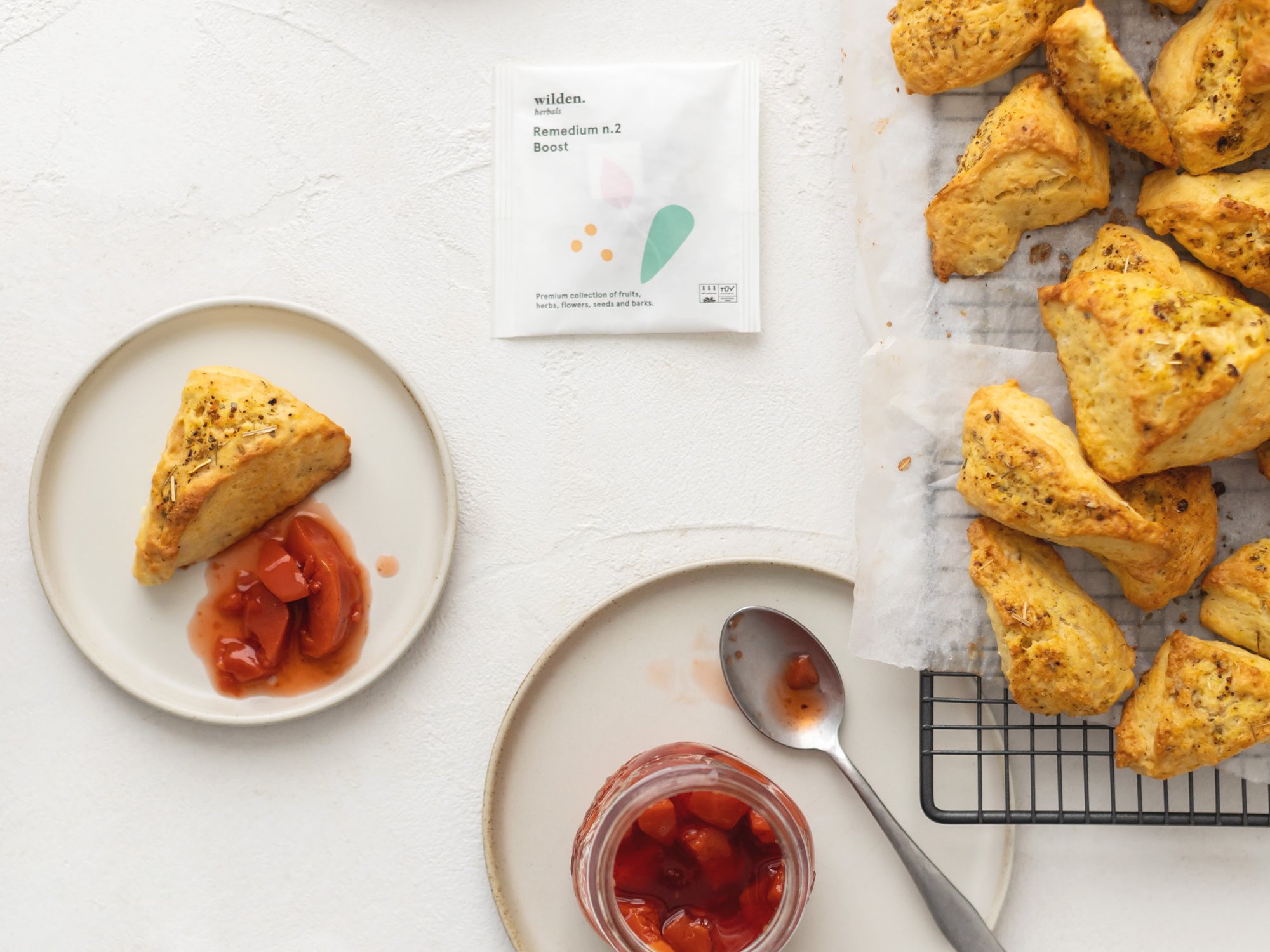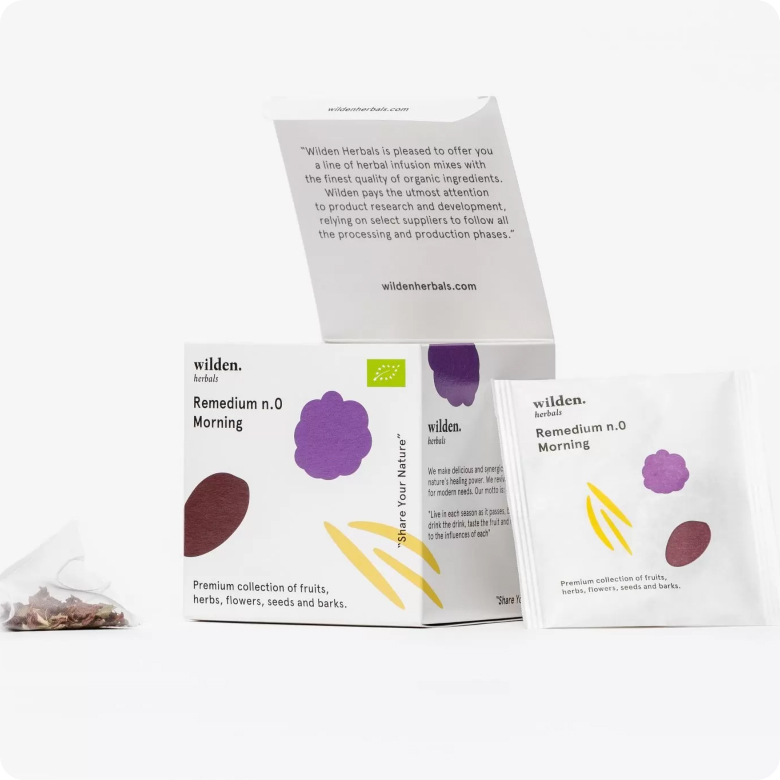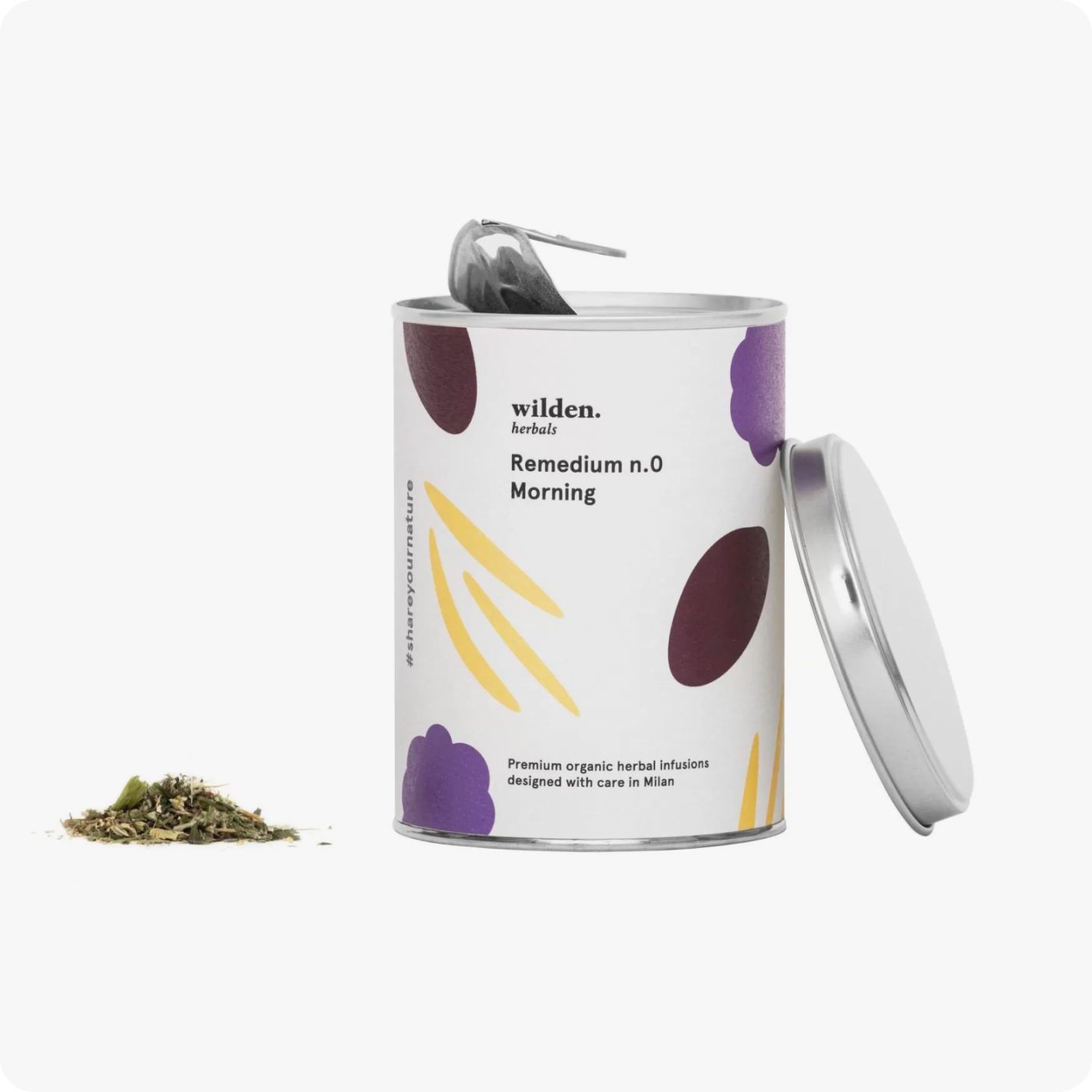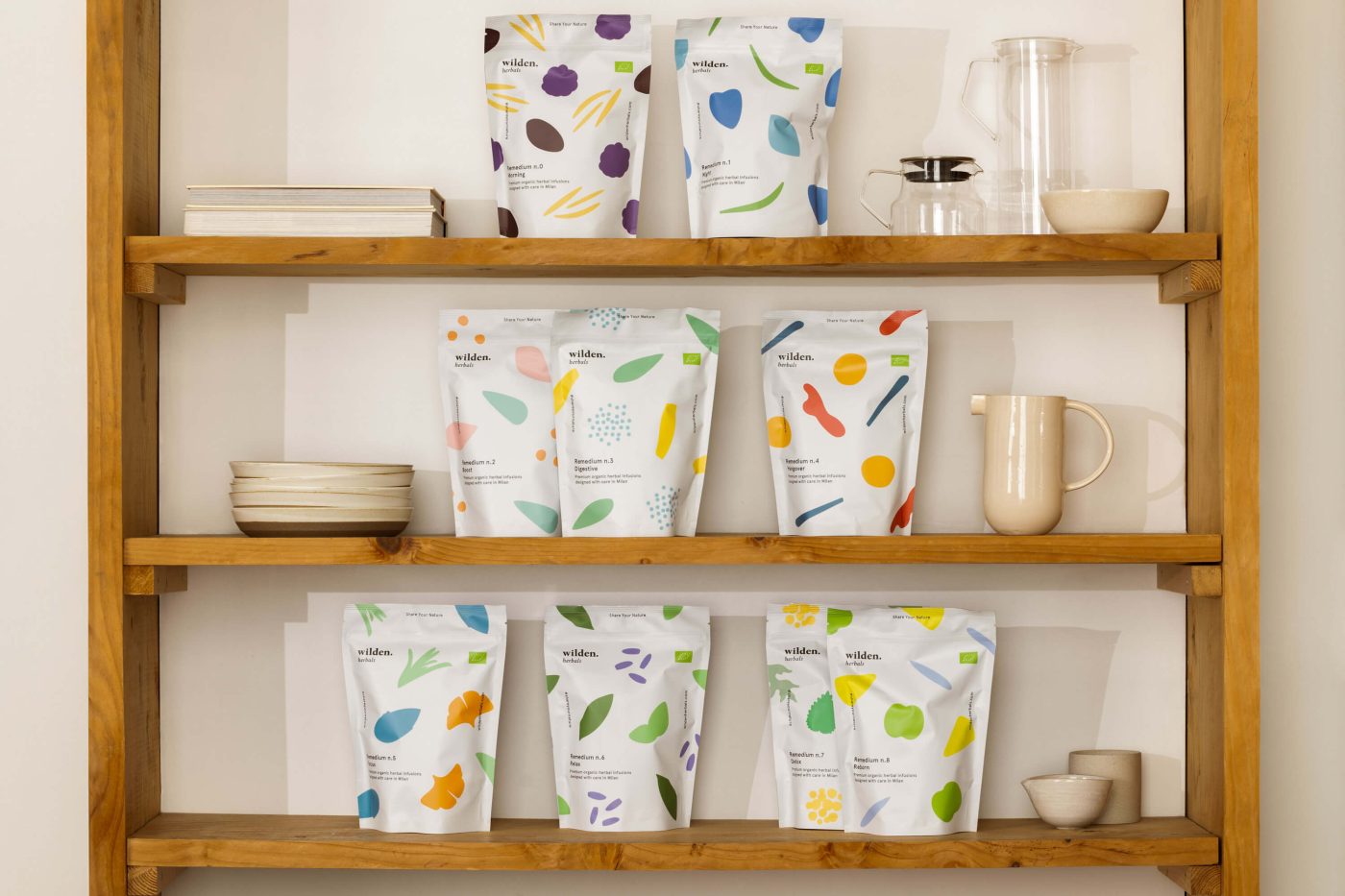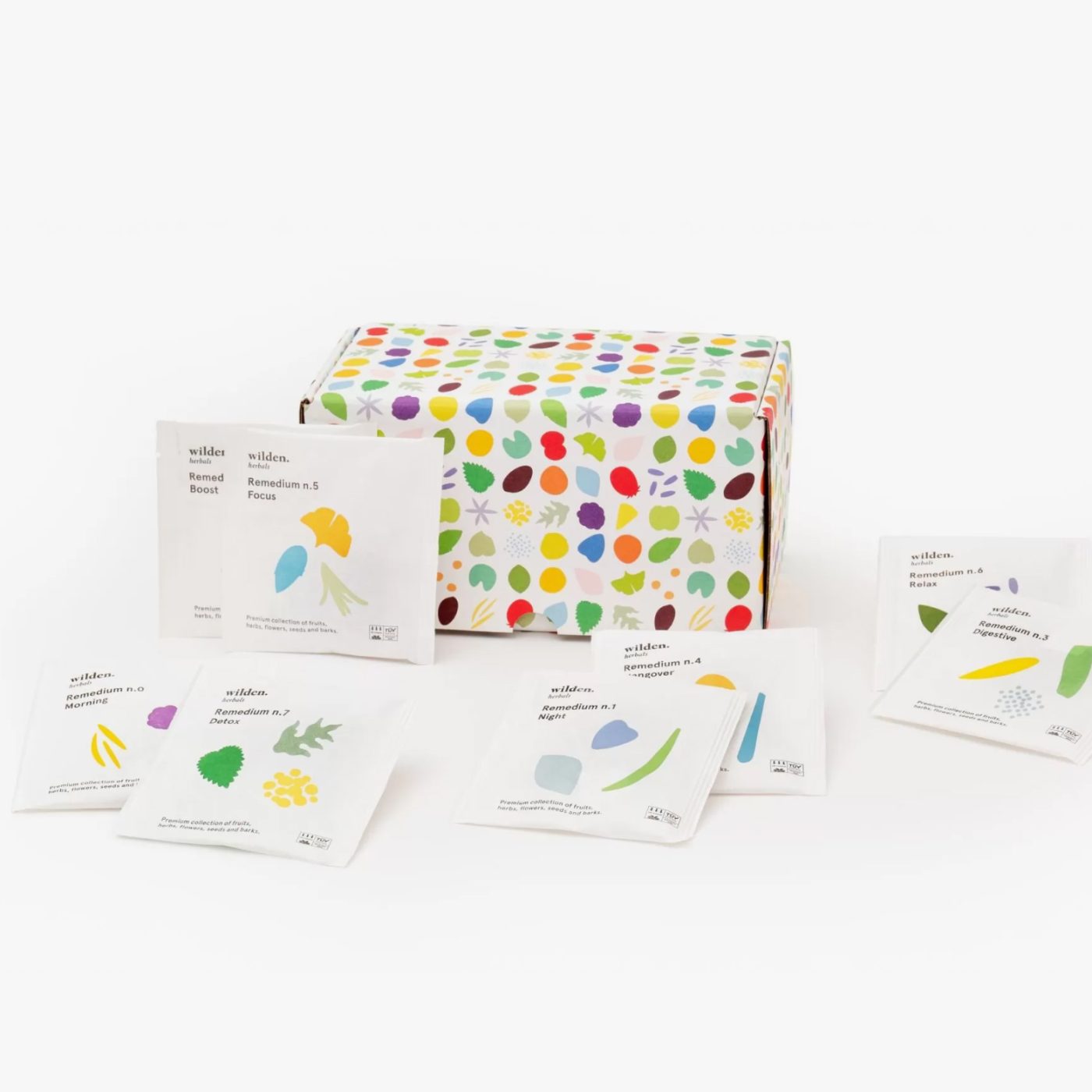Remedium No. 0 – Morning
From composition to benefits, Wilden.herbals chronicles its herbal teas one by one on a journey to discover the power of plants.
Remedium No. 0 – Morning is the first infusion mix offered by Wilden.herbals; the dry plant blend is proposed as a morning tonic and energizer, perfect for starting the day.
A mix of 8 herbs that balance and reinforce each other: the sharp, pungent flavor of cocoa and cinnamon are balanced with the sweet honey aroma of honeybush and the nutty taste of rooibos; ginkgo, St. John’s Wort, poppy, and ginseng act synergistically to promote tone, good mood, and energy.

Honeybush, Cyclopia intermedia
Rooibos, Aspalathus linearis
Cinnamon, Cinnamom ceylon
Cacao, Theobroma cacao
Ginkgo, Ginkgo biloba
Hypericum, Hypericum perforatum
Red poppy, Rhoeados papaveris
Siberian ginseng, Eleutherococcus senticosus
This is the composition per 100g:
Honeybush, Cyclopia intermedia
Honeybush is a plant indigenous to the Cape of Good Hope area, South Africa; it is known as a tea substitute, contains no caffeine, and when infused has a distinctive, sophisticated flavor reminiscent of honey. Honeybush has a very low percentage of tannins, but is rich in iflavonoids and pinitol (modified sugar suitable for diabetics, thus promoting insulin action); it has always been known for its expectorant properties and for relieving menopausal symptoms.
Rooibos, Aspalathus linearis
Aspalathus linearis, known as Rooibos or Red Tea is a plant of indigenous African tradition native to the south of the continent. When infused (between 3 and 5 min) it releases a hazy nutty taste and a dark red color; the plant contains no caffeine and has high Vitamin C contents and several minerals such as Calcium, Magnesium, Potassium, Iron, Fluoride and Phosphorus. It stands out for its antioxidant function associated with a reduction in LDL and an increase in HDL (cholesterol reduction and blood pressure control).
Cinnamon, Cinnamomi ceylon
Cinnamon, the queen of spices, is a plant that has been used for centuries in culinary traditions around the world; likewise, its therapeutic properties have always been known and appreciated, especially in Eastern medicine. An antioxidant, anti-inflammatory and antibacterial par excellence, it helps reduce cholesterol and hypertension and is associated with increased insulin activity (promotes and accelerates sugar metabolism; new studies are confirming its positive effects on Alzheimer’s and Parkinson’s symptoms).

Cacao, Theobroma cacao
Cacao, which is made from the dried seeds of the plant native to the Amazon Basin, has been a prized food worldwide for centuries. Its beneficial and healthful properties associated with its high content of biophenols (the latter are lost and altered during cocoa processing) have always been known. The infused peels, with their distinct bitter and pungent flavor, release effective concentrations of polyphenols with a positive effect on the circulatory system and mood.

Ginkgo, Ginkgo biloba
Ginkgo biloba L. is a prehistoric plant (250 million years old) that has always been prized for its therapeutic and beneficial properties; its dietary and therapeutic uses flourish with the tradition of Chinese medicine and with the dawn of “Western” phytotherapy. Infused leaves release low concentrations of Gingkolides, natural tonics and antioxidants with a veiled digestive action. Ginkolide B is perhaps the main player: it acts strongly on microcirculation and has a strong antioxidant action.

Hypericum, Hypericum perforatum
Hypericum, or St. John’s Wort, is a classic herb in the phytotherapeutic tradition. A classic anti-inflammatory, antioxidant and antibacterial agent, it contains high concentrations of two particular active ingredients: Hypericin and Hyperforin; these are associated with Serotonin and Dopamine receptors (specifically in the re-cap process of these neurotransmitters) with strong antidepressant action. The dried plant infused at low concentrations promotes good mood and micro-circulation.

Red poppy, Rhoeados papaveris
The Red Poppy is a load-bearing herb in herbal medicine that has always been used for its varied therapeutic properties. In addition to a high content of essential minerals and mucilage, it has several alkaloids (the best known and most appreciated are Rodein, Isorodein, and Papaverine) with various antioxidant, anti-inflammatory, astringent, and antispasmodic properties. The infused flower promotes good mood (purely anti-anxiety activity) and digestion.
Siberian ginseng, Eleutherococcus senticosus
Siberian Ginseng is a shrub native to the Asian continent. Its dietary and medicinal use has deep and ancient origins; the plant owes its properties to the eleutheroside family of glycosides (mainly A and D). These molecules have a pronounced effect on the immune system and anti-stress, with energizing, invigorating, and aphrodisiac qualities that are recounted throughout the literatures and still appreciated worldwide. The plant owes its properties to the eleutheroside family of glycosides (mainly A and D).

Remedium No. 0 – Morning is an herbal tea to start the day with the right rhythm and a good taste. Chocolate infuses this drink with a pleasant, round, full aroma, while the botanicals it is made of contribute to an energetic, yet natural awakening.
© 2020 Wilden.herbals – Contents are the property of Wilden.herbals S.r.l., reproduction is prohibited
Sources:
- Wagner, H., & Ulrich-Merzenich, G. (2013). Evidence and rational based research on Chinese drugs. Wien: Springer.
- Phytotherapy, rational use of plant drugs, F. Capasso G. Grandolini A.A. Izzo Springer.
- Teris A van Beek, Chemical analysis of Ginkgo biloba leaves and extracts, in Journal of Chromatography A, vol. 967, no. 1, Aug. 16, 2002.
- Bates SH, Jones RB, Bailey CJ, Insulin-like effect of pinitol, British Journal of Pharmacology 2000; 130(8): 1944-1948
- Kamara BI, et al, Polyphenols from honeybush tea, Journal Agricultural Food Chemistry 2003; 51(13): 3874-3879
- Kenneth M. Klemow, Andrew Bartlow and Justin Crawford, Herbal Medicine: Biomolecular and Clinical Aspects.
- Barnes Joan, Anderson A. Linda, Phillipson David J. Herbal Medicines, Pharmaceutical Press 2007.
- Blumenthal M., Goldberg A., Brinckmann J (Ed). Expanded Commission E Monographs, American Botanical Council and Integrative Medicine Communications 2000.
- European Scientific Cooperative on Phytotherapy (Ed). Melissea folium, ESCOP Monographs on the Medicinal Uses of Plants Drugs, Centre for Complementary Health Studies, Université d’Exeter 1996.
- Franchomme P. et Pénoël D. L’aromathérapie exactement. Encyclopédie de l’utilisation thérapeutique des huiles essentielles. (Aromatherapy exactly. Eencyclopedia of the therapeutic use of essential oils).
- Roger Jollois Éditeur 1990 Pizzorno JE Jr, Murray Michael T (Ed). Textbook of Natural Medicine, Churchill Livingstone 2006
- Organisation mondiale de la santé (World Health Organization). WHO monographs on selected medicinal plants, vol. 2, Suisse, 2002.

